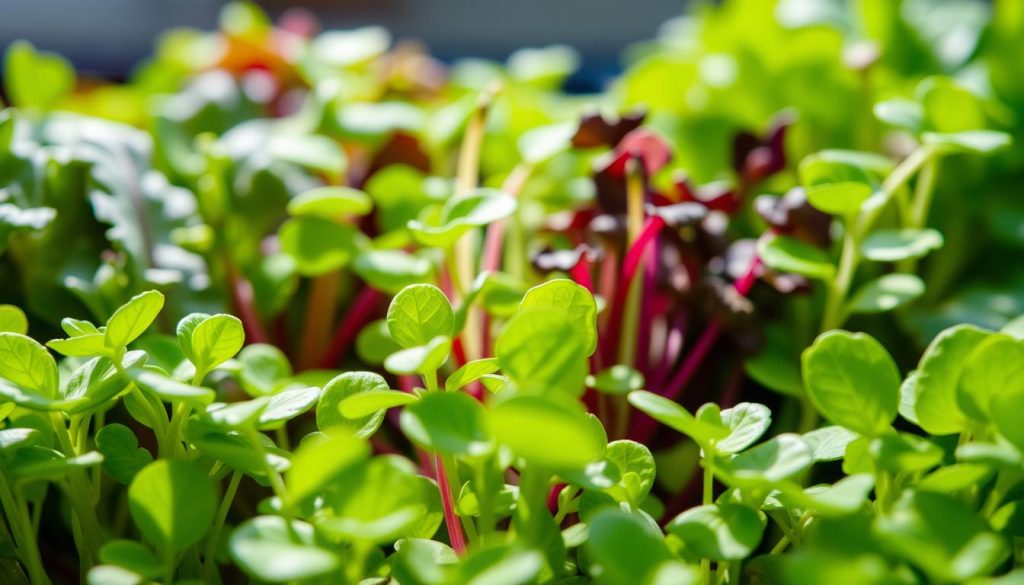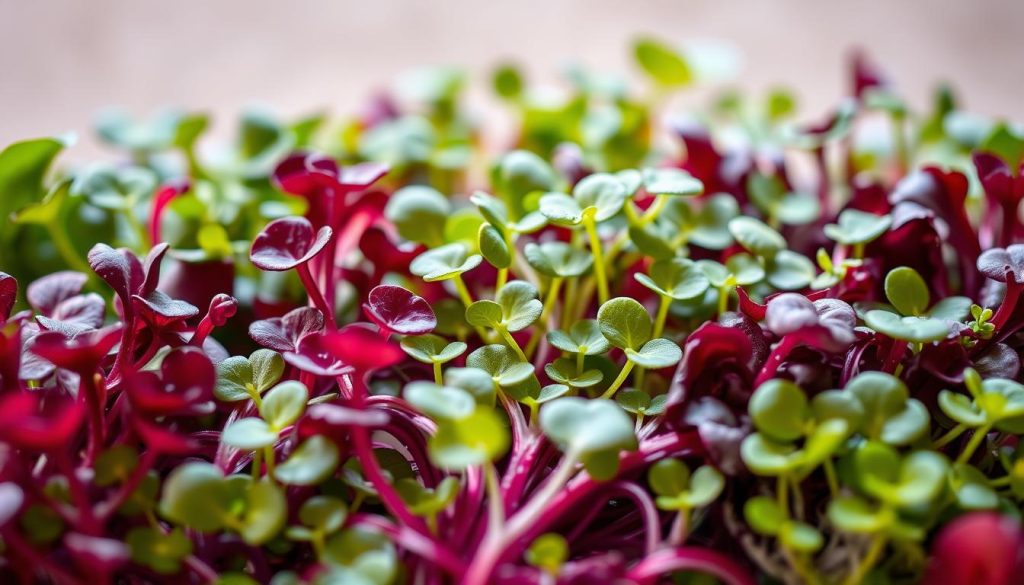The Amazing Health Perks of Microgreens
Explore the amazing world of microgreens, tiny nutritional powerhouses. They are changing the way we eat. These small veggies are full of vitamins and minerals, making them a great addition to any diet.
Microgreens have become very popular, especially after the COVID-19 pandemic. People want foods that are full of nutrients to help them stay healthy. These tiny greens have up to 40 times more nutrients than regular veggies, making them a superfood favorite in many kitchens.
The health benefits of microgreens are impressive. They are ready to eat in just 7-21 days after they start growing. Despite their small size, they are packed with nutrients. This makes them a great choice for anyone looking to eat healthier.
Key Takeaways
- Microgreens contain up to 40 times more nutrients than mature vegetables
- Easy to grow at home in just 1-2 weeks
- Support prevention of chronic diseases
- Low-maintenance and sustainable food option
- Suitable for urban and home cultivation
- Potential to address nutritional deficiencies
What Are Microgreens?
Microgreens are tiny, packed with nutrients, and add a big flavor boost to meals. They are harvested when they are about 1-3 inches tall. Unlike sprouts, microgreens have a strong taste and lots of nutrition.
There are around 60 different types of microgreens, each with its own taste and health benefits. These small greens come from seeds of many plants, like broccoli and sunflowers.
- Brassicaceae (like broccoli and radish)
- Asteraceae (sunflower and amaranth)
- Apiaceae (carrots and cilantro)
- Amaryllidaceae (onions and garlic)
Organic Microgreens: A Nutrient Powerhouse
Organic microgreens are super healthy. They have more nutrients than big plants. Some microgreens have vitamins and antioxidants nine times more than full-grown plants.
Nutritional Composition
Microgreens are full of good stuff like fiber and vitamin K. They help keep blood pressure healthy. For example, red cabbage microgreens can lower bad cholesterol and fight inflammation.
Growing these greens takes only 7-21 days. They are easy to grow at home and are great for anyone who cares about their health.
Why Microgreens Are Nutrient Powerhouses
Microgreens are tiny nutritional giants. They pack an incredible punch of vitamins, minerals, and antioxidants. These miniature greens are not just a garnish but a concentrated source of nutrition that can transform your diet.
The nutritional value of microgreens is truly remarkable. Research shows these young plants have significantly higher nutrient levels than their mature counterparts. Let’s explore why microgreens are considered nutrient powerhouses:
Vitamin Concentration
- Red cabbage microgreens boast 40 times more vitamin E than mature red cabbage
- Pea shoot microgreens contain 1.5 times more vitamin C than mature pea plants
- Kale microgreens have five times more glucosinolates than mature kale
Antioxidant Properties
Microgreens are loaded with powerful antioxidants. These tiny plants are rich in phytochemicals like:
- Chlorophyll
- Carotenoids
- Polyphenols
- Flavonoids
The concentrated nature of microgreens means you can get a substantial nutritional boost from just a small serving. Their ability to be harvested within 1-3 weeks after sprouting ensures maximum nutrient density. This makes them an excellent addition to a health-conscious diet.
Boosting Immune Health with Microgreens
Microgreens are tiny but mighty, packed with nutrients that boost your immune system. They offer a concentrated dose of health benefits. This helps protect your body from many health challenges.

Microgreens are nutritional powerhouses. They have up to 40% more nutrients than mature vegetables. This makes them a great choice for a healthy diet.
Key Nutrients for Immunity
Some microgreens are especially good for your immune system:
- Red cabbage microgreens have six times more vitamin C than mature red cabbage
- Broccoli microgreens have up to 100 times more sulforaphane than adult broccoli
- Sunflower microgreens are full of vitamin E, fighting off free radicals
Easy Recipes with Microgreens to Support Immune Function
Adding microgreens to your diet is easy and tasty. Here are some quick ideas:
- Sprinkle radish or broccoli microgreens on salads
- Add microgreens to morning smoothies for extra nutrition
- Use them as a garnish for sandwiches, soups, and omelets
- Make a microgreen pesto for a healthy spread
By adding these tiny greens to your meals, you support your immune system. You also get to enjoy new flavors and textures.
Microgreens and Heart Health
Microgreens are tiny but mighty for your heart. They are full of nutrients that help keep your heart healthy. These tiny greens are packed with essential nutrients for your heart’s well-being.
Heart-Healthy Nutrients in Microgreens
Microgreens are great for your heart thanks to several key nutrients:
- High levels of antioxidants that combat inflammation
- Potassium for blood pressure regulation
- Folate supporting healthy blood circulation
- Vitamin K for proper blood clotting
Scientific Evidence Supporting Cardiovascular Protection
Studies show that microgreens are good for your heart. Animal studies found that these greens can:
- Lower triglyceride levels
- Reduce “bad” LDL cholesterol
- Decrease overall heart disease risk
Radish microgreens are rich in minerals like calcium and omega-3 fatty acids. Broccoli microgreens may help manage blood sugar levels, which is good for your heart.
Adding a small amount of microgreens to your meals can help your heart. They offer natural support for your cardiovascular system.
Digestive Health Benefits of Microgreens
Microgreens are more than just small plants with strong flavors. They are key players in supporting digestive health. They are full of nutrients that can greatly improve your gut health. These tiny greens are a great way to keep your digestive system healthy.

Despite their small size, microgreens offer big health benefits. They are rich in fiber, which is great for your digestive system. Just one serving can give you a lot of nutritional benefits that help your gut.
Fiber: The Digestive Powerhouse
Fiber is very important for a healthy digestive tract. Microgreens have a lot of dietary fiber. This fiber helps:
- Regulate bowel movements
- Support beneficial gut bacteria
- Promote smooth digestion
- Reduce inflammation in the digestive system
Supporting a Healthy Gut Microbiome
Studies show that microgreens are good for gut health. They have many nutrients that help keep the gut microbiome balanced. This balance is key for:
- Improved immune function
- Better nutrient absorption
- Reduced risk of digestive disorders
Adding microgreens to your diet is a smart move for better digestive health. Their high nutrient content can prevent problems like bloating and constipation. It can also reduce other digestive discomforts.
Microgreens’ Role in Weight Management
Exploring Microgreens for Weight Loss can change how you eat. These small but mighty greens are a tasty way to manage weight without losing flavor or nutrition.
Microgreens are a great choice for those trying to lose weight. They have very few calories, from 5 to 30 per cup. Yet, they are full of nutrients, making them a smart choice for your diet.
Low-Calorie, Nutrient-Dense Options
Looking into Microgreens for Weight Loss? Here’s why they’re good:
- They have very few calories (25-40 per 100 grams)
- They’re full of vitamins and minerals
- They have a lot of fiber, which helps you feel full
- They might even help your metabolism
Satisfying Crunch Without Guilt
Microgreens add a nice crunch that can stop you from eating too much. They come in flavors like arugula, radish, and sunflower. These greens taste great and help you stay on track with your diet.
A study on red cabbage microgreens showed they might help with weight gain and cholesterol. Adding these greens to your meals can make losing weight tasty and healthy.
The Anti-Inflammatory Effects of Microgreens
Microgreens are tiny but mighty, packed with nutrients and anti-inflammatory powers. They fight chronic inflammation, which is a big problem for our health.
These small greens are big on health benefits. They have compounds that lower inflammation in our bodies.
Compounds That Combat Inflammation
Microgreens are full of antioxidants that fight inflammation. They have important compounds that stop harmful free radicals:
- Polyphenols: Powerful plant compounds that fight inflammation
- Flavonoids: Natural protectors of cells
- Carotenoids: Pigments that keep cells healthy
Potential Health Benefits
Eating microgreens regularly may lower inflammation risks. They could help:
- Reduce chronic disease risks
- Keep the heart healthy
- Boost the immune system
- Protect cells from damage
Adding microgreens to your meals is a smart move. It helps manage inflammation and boosts your health.
How to Grow Microgreens at Home
Growing organic microgreens at home is easier than you might think. With just a few simple tools and some patience, you can start your own microgreen garden. Enjoy fresh, nutritious greens right from your kitchen.
To grow microgreens, first gather the necessary supplies. You’ll need:
- Shallow growing trays
- Organic seed mix
- High-quality organic microgreen seeds
- Spray bottle
- Sharp scissors for harvesting
Easy Growing Techniques
The process of growing microgreens is simple. Follow these steps for success:
- Spread a thin layer of organic seed mix in your tray
- Sprinkle seeds evenly across the surface
- Lightly mist with water
- Cover tray to retain moisture
- Place in a warm location with indirect sunlight
Ideal Conditions for Optimal Growth
Creating the right environment is key for healthy microgreens. Most varieties need 6-8 hours of indirect sunlight and consistent moisture. Keep the growing medium damp but not too wet. Temperatures between 60-75°F are best for most microgreens.
In just 7-10 days, you’ll have a nutritious harvest. Organic microgreens offer up to 40 times more nutrients than mature veggies. They’re a great way to boost your diet.
Incorporating Microgreens into Your Meals
Take your cooking to the next level with microgreens. These small greens add a big nutritional boost to your meals. They make simple dishes taste like gourmet food. Plus, they’re packed with health benefits.
Try new things with microgreens. Add Micro Arugula to your pizza, Micro Broccoli to omelets, or Micro Spicy Mix to smoothies. They add color and flavor to your food. Plus, they’re good for your skin, thanks to vitamins C and K.
Flavor Pairing Strategies
Pair microgreens for the best taste. Micro Wasabi Mustard adds spice to sandwiches. Micro Kale brings earthy flavors to stir-fries. Try AeroFarms’ Micro Rainbow Mix for a colorful, nutritious meal.
Quick Culinary Tips
Add microgreens just before serving to keep them fresh. They’re packed with nutrients, up to 40 times more than regular veggies. Use them in different recipes to boost your health and taste buds.